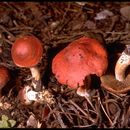en
names in breadcrumbs


Leratiomyces ceres,[1] commonly known as the Redlead Roundhead, is mushroom which has a bright red to orange cap and dark purple-brown spore deposit. It is usually found growing gregariously on wood chips and is one of the most common and most distinctive mushrooms found in that habitat.[1][2] It is common on wood chips and lawns in North America, Europe, Australia, New Zealand and elsewhere.[1] The name Stropharia aurantiaca has been used extensively but incorrectly for this mushroom (together with a number of similar synonyms).
L. ceres may be described as follows.[3][4]
There has been some confusion between L. ceres, which has a fairly thick white stem, and L. squamosus var. thaustus, which has a slender stem and prominent scales below the ring zone (although the two taxa are quite easy to distinguish by sight). Around 1885 Mordecai Cubitt Cooke originated the names Agaricus squamosus f. aurantiacus and Agaricus thraustus var. aurantiacus, and this later gave rise to the name Stropharia aurantiaca.[7] This name is defined by Cooke's illustration to his Handbook of British Fungi and in 2004 Richard Fortey discovered that this illustration was not of L. ceres, as had generally been assumed,[3] but it was L. squamosus var. thaustus.[8] Thus the name aurantiaca is best avoided, being wrong when applied to L. ceres.
The name Agaricus ceres was created in 1888 by Cooke and Massee for the white-stemmed species, and was reclassified as Psilocybe ceres (in 1891) and Leratiomyces ceres (in 2008).[9][3]
Similar species include L. squamosus,[6] Agrocybe putaminum, Gymnopilus sapineus, Psathyrella gracilis,[5] Stropharia squamosa, S. thrausta,[6] and Tubaria furfuracea.[5]
In psilocybin mushroom hunting communities in Australia and New Zealand, L. ceres (or "Larrys" as commonly nicknamed) are scorned as lookalikes and imposters of Psilocybe species on wood chip. Prolific growth in the same habitats and a similar appearance from afar can give false hope of a large bounty, but on closer inspection the species are not particularly alike.
Leratiomyces ceres, commonly known as the Redlead Roundhead, is mushroom which has a bright red to orange cap and dark purple-brown spore deposit. It is usually found growing gregariously on wood chips and is one of the most common and most distinctive mushrooms found in that habitat. It is common on wood chips and lawns in North America, Europe, Australia, New Zealand and elsewhere. The name Stropharia aurantiaca has been used extensively but incorrectly for this mushroom (together with a number of similar synonyms).